Execution or Amnesty? Pavel Lungin’s Lesson on Russian History (Review Article)
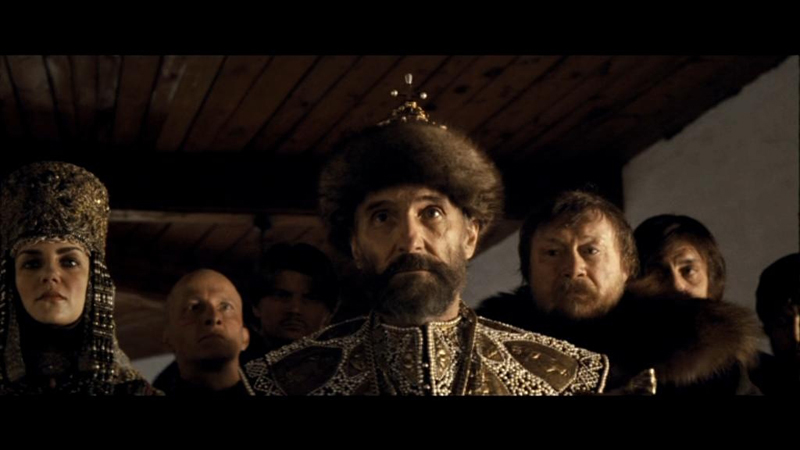 Russian cinema has shown noticeable interest in Russian national history over the past few years. When dealing with representations of history in film, the most enlightening question is not whether the depicted events are true, but rather how the past is viewed from the contemporary perspective. Historical films, therefore, provide insight into the ways history is dealt with in public discourse on the one hand, and how they exert influence on the historical awareness of society on the other.
Russian cinema has shown noticeable interest in Russian national history over the past few years. When dealing with representations of history in film, the most enlightening question is not whether the depicted events are true, but rather how the past is viewed from the contemporary perspective. Historical films, therefore, provide insight into the ways history is dealt with in public discourse on the one hand, and how they exert influence on the historical awareness of society on the other.
 Pavel Lungin’s 2009 film Tsar, the latest work of the well-known Russian filmmaker, focuses on one of the most controversial personalities of Russian history: Tsar Ivan the Terrible (1530–84). What Lungin’s historical portrayal may reveal to the audience about contemporary Russian society is of particular interest, since the film has been widely perceived as a critique of Russian history. To approach this question, the film’s three main protagonists will be examined: Ivan the Terrible, representing state power; his counterpart Filipp, representing the Orthodox Church; and the people.
Pavel Lungin’s 2009 film Tsar, the latest work of the well-known Russian filmmaker, focuses on one of the most controversial personalities of Russian history: Tsar Ivan the Terrible (1530–84). What Lungin’s historical portrayal may reveal to the audience about contemporary Russian society is of particular interest, since the film has been widely perceived as a critique of Russian history. To approach this question, the film’s three main protagonists will be examined: Ivan the Terrible, representing state power; his counterpart Filipp, representing the Orthodox Church; and the people.
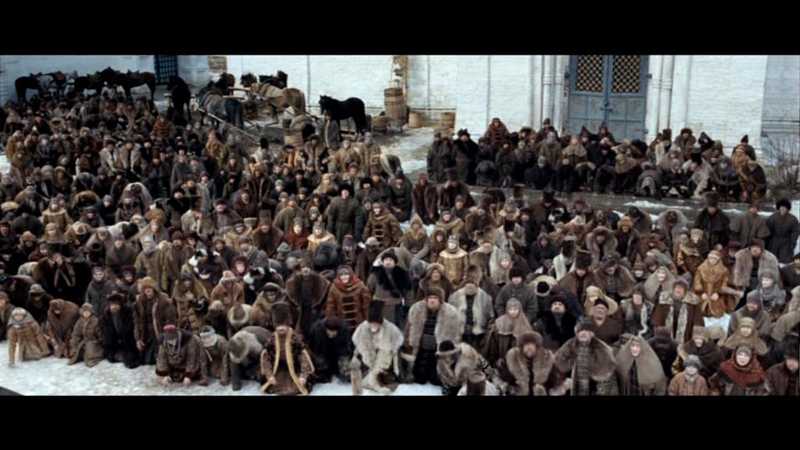 The film itself is far from a conventional historical chronicle, like Vladimir Khotinenko’s 1612: A Chronical of the Time of Troubles (2007), or Andrei Kravchuk’s Admiral (2008), or even Vladimir Bortko’s Taras Bul’ba (2009). Tsar is undoubtedly opposed to the current “vogue” of the patriotic formula “za tsaria i otechestvo” (for tsar and fatherland)(O.P. Zidorova. “Istoriia Rossii. Tochki zrenija 2008.” In Khroniki kinopretsessa 2008. (Moscow: 2009), 110.) , it does not just conventionally mingle history, costume drama, battle scenes, and a sentimental love story with an idealized heroic figure. Instead Tsar invokes the “dark middle ages” and challenges the viewer with realistic depictions of torture, ailment and poverty.
The film itself is far from a conventional historical chronicle, like Vladimir Khotinenko’s 1612: A Chronical of the Time of Troubles (2007), or Andrei Kravchuk’s Admiral (2008), or even Vladimir Bortko’s Taras Bul’ba (2009). Tsar is undoubtedly opposed to the current “vogue” of the patriotic formula “za tsaria i otechestvo” (for tsar and fatherland)(O.P. Zidorova. “Istoriia Rossii. Tochki zrenija 2008.” In Khroniki kinopretsessa 2008. (Moscow: 2009), 110.) , it does not just conventionally mingle history, costume drama, battle scenes, and a sentimental love story with an idealized heroic figure. Instead Tsar invokes the “dark middle ages” and challenges the viewer with realistic depictions of torture, ailment and poverty.
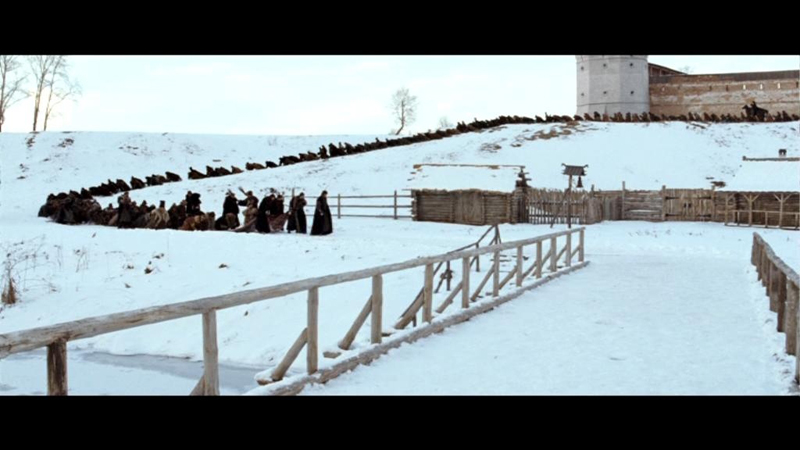 In the historical and cultural context of today’s Russia, there are two representations of Tsar Ivan IV that are most relevant for Lungin’s film. The first is Vladimir Sorokin’s novel A Day in the Life of an Oprichnik (Den’ oprichnika, 2006), a parable of neo-medieval stateterror in 2027. The second is Sergei Eisenstein’s unfinished film trilogy of the 1940s. In both texts Tsar Ivan IV and Stalin are linked. From the present perspective both statesmen represent state-initiated violence in the service of political and social goals. In light of this juxtaposition of leaders it seems impossible to make a film about the 16th century without simultaneously talking about 20th-century Russia and its present political situation. Since such a text will have to deal with the legacy of despotic authoritarian politics in Russia, its critical attitude is self-evident.
In the historical and cultural context of today’s Russia, there are two representations of Tsar Ivan IV that are most relevant for Lungin’s film. The first is Vladimir Sorokin’s novel A Day in the Life of an Oprichnik (Den’ oprichnika, 2006), a parable of neo-medieval stateterror in 2027. The second is Sergei Eisenstein’s unfinished film trilogy of the 1940s. In both texts Tsar Ivan IV and Stalin are linked. From the present perspective both statesmen represent state-initiated violence in the service of political and social goals. In light of this juxtaposition of leaders it seems impossible to make a film about the 16th century without simultaneously talking about 20th-century Russia and its present political situation. Since such a text will have to deal with the legacy of despotic authoritarian politics in Russia, its critical attitude is self-evident.
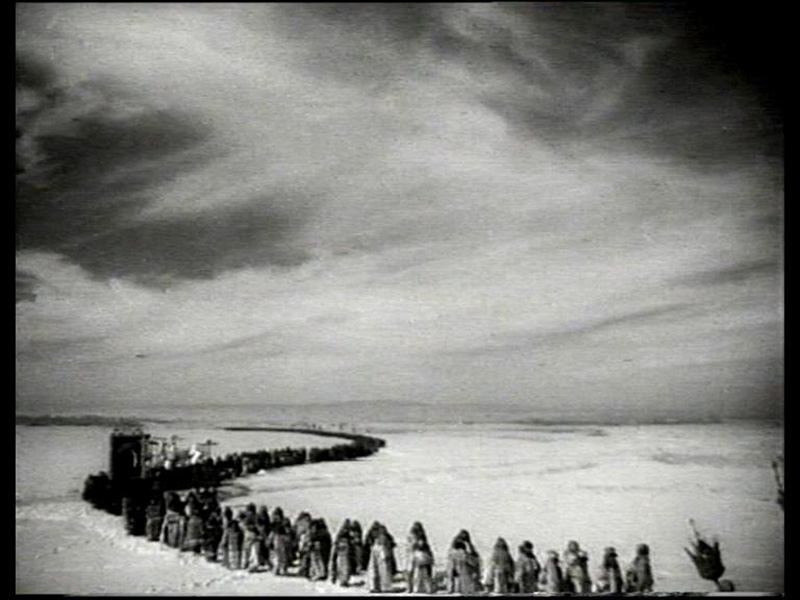 Lungin’s film takes place in 1568, a particularly tumultuous year in Tsar Ivan’s reign, and it focuses on the conflict between the Tsar and his Metropolitan, Filipp. The crux of the historical conflict was the tsar’s political police who was responsible for mass repressions, public executions, and the confiscation of land from the aristocracy. The conflict between church and state eventually resulted in the death of Filipp and in the subsequent wave of tortures and executions of the Orthodox elite. A century later, Filipp’s resistance was recognized as martyrdom and he was canonized in 1652.(The historical background is reconstructed in the film review by Stephen M. Norris, who also provides a detailed description of the film’s plot [http://www.kinokultura.com/2010/28r-tsar-sn.shtml]. Norris refers to two works on the Metropolitan: George Fedotov. St. Filipp, Metropolitan of Moscow: Encounter with Ivan the Terrible. Translated by Richard Haugh and Nickolas Lupinin (Belmont: 1978); and Roy Robson. Solovki: The Story of Russia Told Through Its Most Remarkable Islands (New Haven: 2004).)
Lungin’s film takes place in 1568, a particularly tumultuous year in Tsar Ivan’s reign, and it focuses on the conflict between the Tsar and his Metropolitan, Filipp. The crux of the historical conflict was the tsar’s political police who was responsible for mass repressions, public executions, and the confiscation of land from the aristocracy. The conflict between church and state eventually resulted in the death of Filipp and in the subsequent wave of tortures and executions of the Orthodox elite. A century later, Filipp’s resistance was recognized as martyrdom and he was canonized in 1652.(The historical background is reconstructed in the film review by Stephen M. Norris, who also provides a detailed description of the film’s plot [http://www.kinokultura.com/2010/28r-tsar-sn.shtml]. Norris refers to two works on the Metropolitan: George Fedotov. St. Filipp, Metropolitan of Moscow: Encounter with Ivan the Terrible. Translated by Richard Haugh and Nickolas Lupinin (Belmont: 1978); and Roy Robson. Solovki: The Story of Russia Told Through Its Most Remarkable Islands (New Haven: 2004).)
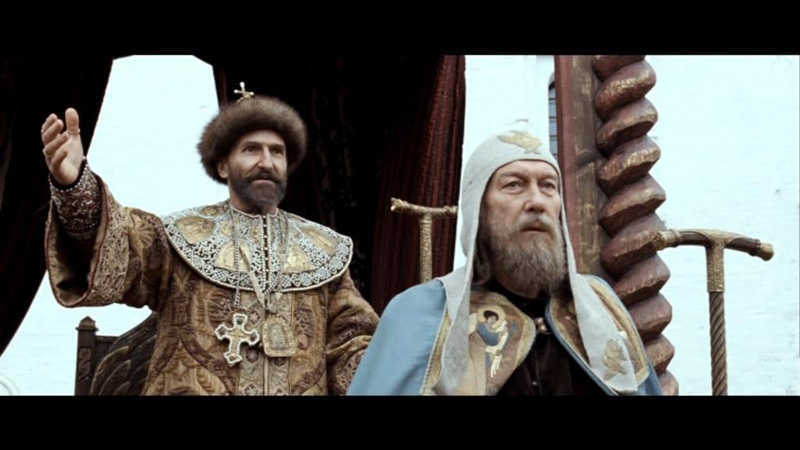 Historian Dmitrii Volodikhin sees in the historical Ivan the Terrible two very different personalities: on the one hand, he sees Ivan IV as a “formidable, long-sighted, and wise leader, a great strategist, an outstanding diplomat, a subtle writer and Christian of high moral standards.” On the other hand, a “half insane maniac, a bloody murderer, a man who implanted in the Russian people an inclination to political repression, who sacrificed the best forces of the Russian army in the battlefield and practically destroyed the church.”(Elena Iakovleva. “Bez tsaria. Pochemu iskusstvo ne mozhet byt’ uchebnikom istorii.” In Rossiiskaia gazeta, February 10, 2010 [http://www.rg.ru/2010/02/10/volodihin.html].) There is no doubt that Lungin addresses both aspects of the Tsar’s personality, not only portraying him as a god-fearing, reflective, ascetic man who bemoans his loneliness, but also as a diabolical figure suffering from paranoia and a misguided apocalyptic religiosity, and who in the end enthrones himself as the manifestation of God on earth.
Historian Dmitrii Volodikhin sees in the historical Ivan the Terrible two very different personalities: on the one hand, he sees Ivan IV as a “formidable, long-sighted, and wise leader, a great strategist, an outstanding diplomat, a subtle writer and Christian of high moral standards.” On the other hand, a “half insane maniac, a bloody murderer, a man who implanted in the Russian people an inclination to political repression, who sacrificed the best forces of the Russian army in the battlefield and practically destroyed the church.”(Elena Iakovleva. “Bez tsaria. Pochemu iskusstvo ne mozhet byt’ uchebnikom istorii.” In Rossiiskaia gazeta, February 10, 2010 [http://www.rg.ru/2010/02/10/volodihin.html].) There is no doubt that Lungin addresses both aspects of the Tsar’s personality, not only portraying him as a god-fearing, reflective, ascetic man who bemoans his loneliness, but also as a diabolical figure suffering from paranoia and a misguided apocalyptic religiosity, and who in the end enthrones himself as the manifestation of God on earth.
In an interview, Lungin describes his main protagonist as a “sinner, a saint, a chastiser”—but first and foremost as an actor, “all his life being yurodstvo, skomoroshestvo(hideousness and buffoonery), a permanent theater.”(Pavel Lungin. “Vechnoe iskushenie Rossii” (interview with Julia Shigareva). In AiF (Ukraine), 16/2008 [http://www.aif.ua/society/article/16085].) This figures of the holy fool creates a link with Lungin’s previous film, The Island. The parallels between the two films can be found on several levels. First, is the eccentric behavior of the main protagonist—eccentricity being one of the outstanding qualities of the lead actor Petr Mamonov; and second, is the religious focus of both films (and for which Lungin was praised by various representatives of the Orthodox Church); and third, is a clear thematic parallel in the sinner who either becomes a saint (The Island) or is shown as the penitent (Tsar) demonstrating his contrition through various eccentricities.
Lungin depicts the people of Tsar Ivan’s Russia as both servile and blood-thirsty; a mob who might be at home in the Roman Collosseum. Some of the ideas that underlie motivations in this portrayal lie in certain 19th-century national ideas, particularly Pushkin’s tragedy Boris Godunov. Pushkin’s famous play ends with the people silenced in the face of the cruel regime. Lungin’s film also touches on the 20th century treatment of masses by Soviet director Sergei Eisenstein. Lungin’s most direct reference to Eisenstein’s films in Ivan the Terrible appears in the opening sequence of the film, when Ivan appears before his people, laments the absence of a metropolitan in Moscow and is carried on a carpet across the snow. The crowd slowly follows behind him in a long procession. The shot echoes the procession of the people at the end of Part I of Eisenstein’s Ivan the Terrible. However in contrast to Eisenstein who in this scene presents the visual apotheosis of the totalitarian leader, Lungin shows the people being swept along with Tsar Ivan’s madness.
 In contrast to these nationalist representations of the people, Lungin integrates his character into the narrative of a film that can be interpreted as an allegory of Russia. The blond girl Masha, together with the icon of the Theotokos of Vladimir (regarded as the holy protectress of Russia, given to her by the Tsar) creates a narrative thread within the film’s plot that deserves special notice. The girl is repeatedly referred to as blazhennaia (blessed), she is mute for the majority of the film and as a child she appears to have no will of her own. However, her character incorporates different notions of Russia. She is naïve, innocent and young, she is uncomplaining and patient, credulous and suffering. In the film’s narrative she flees the oprichniki and seeks the protection of the Metropolitan Filipp. Masha saves the Russian troops with the help of the icon of Theotokos of Vladimir and is then seduced and abused by the Tsar and his henchmen. When Ivan brings down God’s judgment by setting a bear loose on his prisoners she is killed by the bear while trying to protect Filipp’s nephew, Ivan Kolycha, with the icon.
In contrast to these nationalist representations of the people, Lungin integrates his character into the narrative of a film that can be interpreted as an allegory of Russia. The blond girl Masha, together with the icon of the Theotokos of Vladimir (regarded as the holy protectress of Russia, given to her by the Tsar) creates a narrative thread within the film’s plot that deserves special notice. The girl is repeatedly referred to as blazhennaia (blessed), she is mute for the majority of the film and as a child she appears to have no will of her own. However, her character incorporates different notions of Russia. She is naïve, innocent and young, she is uncomplaining and patient, credulous and suffering. In the film’s narrative she flees the oprichniki and seeks the protection of the Metropolitan Filipp. Masha saves the Russian troops with the help of the icon of Theotokos of Vladimir and is then seduced and abused by the Tsar and his henchmen. When Ivan brings down God’s judgment by setting a bear loose on his prisoners she is killed by the bear while trying to protect Filipp’s nephew, Ivan Kolycha, with the icon.
The narrative of the girl and the icon is a kind of didactic tale about Russia: if Russia is in the hands of the Church, it is safe; but if it is left at the mercy of a corrupt secular power, it is doomed. In drawing on Russian folk legends and tales, (such as the legend of the icon of the Theotokos of Vladimir saving Russia from penetrating foreign enemies), Lungin positions himself as an author who strives to recreate and revive traditional narrative genres.
While Ivan represents the secular appropriation of God’s judgment, Filipp stands for the Christian belief in God’s Judgment and grace. The conflict between these two opposing characters and ideas form the core of the film’s narrative structure. Tsar Ivan’s rise to a judge with the power over life and death is linked to the deposition of Filipp as Metropolitan. Moreover, the performance of the actors in these roles (Ivan; Filipp) is largely based on contrast: Petr Mamonov’s eccentric performance contrasts the restrained performance of Oleg Iankovskii.
In contrast to the Tsar’s bloody descent, Lungin shows the metropolitan’s ascent to martyrdom. By placing the emphasis on humanistic values, Lungin aims to recreate the spiritual atmosphere of Andrei Tarkovskii’s films, in particular that of medieval Russia in Andrei Rublev. Lungin advocates the return to spiritual values through orthodox belief, emphasizing the ideas of eternity and feelings of shame and penance.(Ibid.)
Apart from the significance ascribed to orthodox belief in the narrative structures of Lungin’s latest films, the rituals of the Orthodox Church are widely performed on the screen. With the exception of part IV, every part of Tsar begins and ends with either prayer or extracts from liturgical ceremonies. Lungin even demonstrates the cinematic qualities of praying, presenting Filipp’s prayer in a short montage sequence reminiscent of video clips.
 The numerous references to orthodox belief, orthodox ceremonies and the institution of the Orthodox Church itself, are not only found in the film’s narrative, but also play a vital role in the paratexts of the film in the media. The newspaper Komsomol’skaia Pravda, for example, reported that before the film’s release Oleg Iankovskii asked for and received Patriarch Aleksii II’s blessing for work on the film.(Aleksandr Nechaev. “‘Tsar,’ Pavla Lungina: Pered nachalom s’emok Iankovskii poluchil blagoslovenie u Alekseia II.” In Komsomol’skaia Pravda, November 3, 2009 [http://kp.ru/daily/24388/566871/].) Furthermore, Lungin engaged a number of clergymen as advisors, and the practicing priest Ivan Okhlobystin took the role of Ivan’s blasphemous fool Vassian, which finally lead to the dismissal of the priest in February 2010.(Anton Kurilovich and Mariia Ermachenko. “Mezhdu ekranom i amvonom. Ivan Okhlobystin o sluzhenii v tserkvi i sud’be aktera.” In Nezavisimaia gazeta, February 17, 2010 [http://religion.ng.ru/art/2010-02-17/4_ohlobystin.html].)
The numerous references to orthodox belief, orthodox ceremonies and the institution of the Orthodox Church itself, are not only found in the film’s narrative, but also play a vital role in the paratexts of the film in the media. The newspaper Komsomol’skaia Pravda, for example, reported that before the film’s release Oleg Iankovskii asked for and received Patriarch Aleksii II’s blessing for work on the film.(Aleksandr Nechaev. “‘Tsar,’ Pavla Lungina: Pered nachalom s’emok Iankovskii poluchil blagoslovenie u Alekseia II.” In Komsomol’skaia Pravda, November 3, 2009 [http://kp.ru/daily/24388/566871/].) Furthermore, Lungin engaged a number of clergymen as advisors, and the practicing priest Ivan Okhlobystin took the role of Ivan’s blasphemous fool Vassian, which finally lead to the dismissal of the priest in February 2010.(Anton Kurilovich and Mariia Ermachenko. “Mezhdu ekranom i amvonom. Ivan Okhlobystin o sluzhenii v tserkvi i sud’be aktera.” In Nezavisimaia gazeta, February 17, 2010 [http://religion.ng.ru/art/2010-02-17/4_ohlobystin.html].)
The confrontation of two diametrically opposed characters, representing two antithetic ideas and views of power and society are at the center of Lungin’s film. Lungin offers no alternative between kaznit’ (execution) and pomilovat’ (amnesty). The Tsar means to execute the subjects he distrusts, whereas the Metropolitan pleads for everybody’s amnesty. In contrast to the saturation of the cinematic image, by means of which history is visually presented, a void opens up between darkness and light, between good and evil. The question of how political power functions in society is not touched upon. Instead Lungin presents a semi-glamorous surface, heroes who are ready to die for truth.They are ennobled by history and ostentatious orthodox rituals in the background of the naturalistically depicted atrocities of medieval life. If Lungin had really wanted to impart a message about Russian history, one that is applicable to the current situation, he probably should not have chosen Ivan the Terribleand the Metropolitan Filipp.




